What is radiator bleeding?
Bleeding a radiator releases any air from the central heating system that has become caught in the space at the top of your radiators. Doing this regularly helps to keep your heating system running economically because trapped air inhibits the efficiency that heat is transferred from your boiler throughout your home. You’ll usually notice that your radiator needs bleeding when you feel ‘cold spots’ on the surface of the radiator near the top.
You see, air is less dense than water so the bubbles make their way through the pipes and up into the top cavity of the radiator. Air is also an insulator which means that the heat from your boiler isn’t transferred effectively through the radiators and into your room.
How easy is it?
It’s very easy to do yourself, even if you’re not a DIY person you should have no issues bleeding your radiators as it only requires one adjustment to the bleed valve. We’ll guide you through with our simple step-by-step process so it’s as easy and seamless as possible for you.
How long does it take?
Bleeding usually takes around 15 minutes per radiator but this can vary depending on how much pressure there is in the system. If you’ve got lots of steam coming out then it will be easier for you to get the air pocket out faster. Also, if you’ve got multiple radiators with cold spots then you’ll need to multiply 15 minutes by the amount of radiators that need bleeding.
Steps to bleed your radiators:
- Turn your central heating on
- Check each radiator for cold spots
- Turn the central heating off and allow to cool
- Locate the bleed valve at the top of the radiator
- Place a container or towel below the bleed valve
- Open the bleed valve with your bleed key (turn anti-clockwise)
- Listen for a hissing sound of air escaping
- Once the hissing stops, close the bleed valve (turn clockwise)
- Repeat the process for your other cold radiators
- Check your boiler pressure
Tools you’ll need:
Step 1: Turn Your Central Heating On
Simply turn on your central heating system by pressing the main control button located on the front panel of your boiler. This will start the pump running and pressurise the entire system ready for use. The indicator light above the control panel will illuminate green once everything is working correctly.
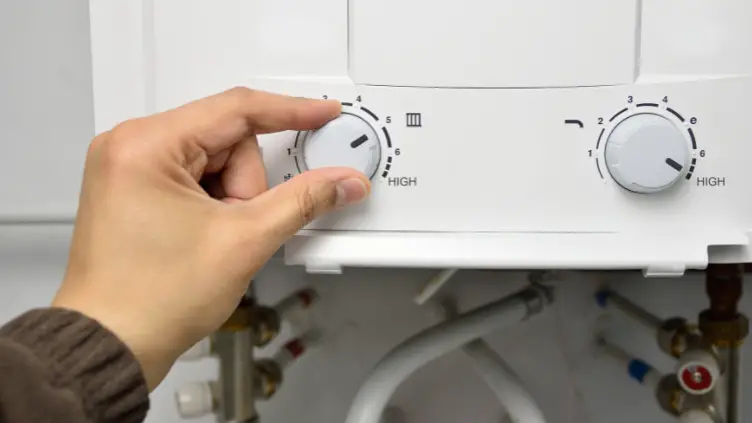
You may also need to adjust your thermostat or heating schedule in order for the radiators to begin heating up.
Step 2: Check Each Radiator For Cold Spots
Make your way around your home and check every single radiator for any signs of cold spots – these are usually located at the top of the radiator but if your system is really full of air you may find that almost the entire radiator is cold from top to bottom.
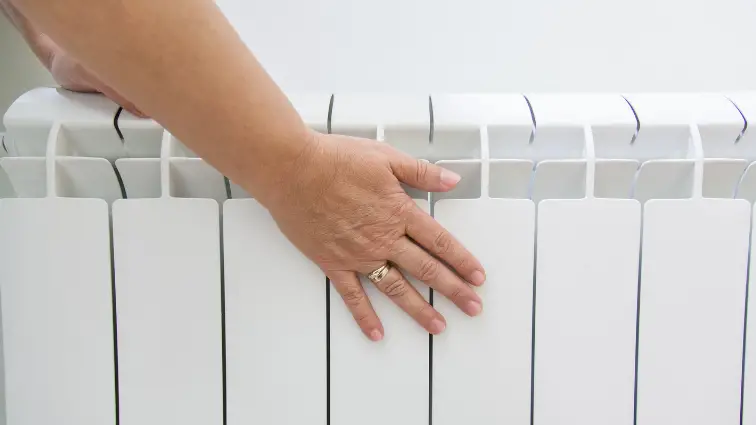
If you notice that it’s just the bottom of the radiator that is cold, this could be a sign that you’ve got sludge and debris blocking up your system. You can clear this sludge by flushing out your radiator with a garden hose or hiring a qualified plumber to conduct a full Power Flush of your entire heating system.
Step 3: Turn the central heating off and allow to cool
Once you’ve located all of the cold spots, turn your central heating off and allow 60+ minutes for the hot water in the system to cool down. You don’t want to scold yourself if any hot air or water comes out of the bleed valve and onto your hands.
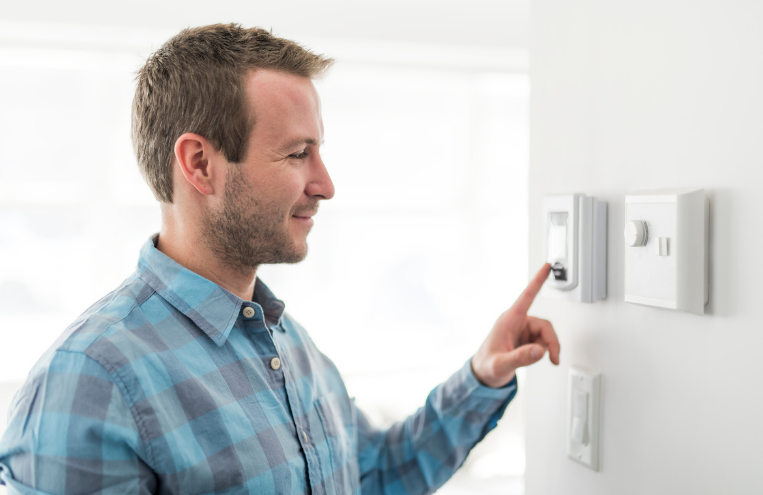
Can you bleed radiators with the central heating on?
It is not recommended to keep the central heating on during the bleed process as hot steam and water can be ejected from the bleed vent which can scold your skin or burn your eyes. It is always advised to turn the boiler off and allow the hot water to cool before attempting to release the air from the system.
Step 4: Locate the bleed valve at the top of the radiator
Make your way to the first radiator that you’d like to vent and locate the bleed valve at the top of the radiator. You should see as a small pin within a circular or angular surround which matches the shape of the key.
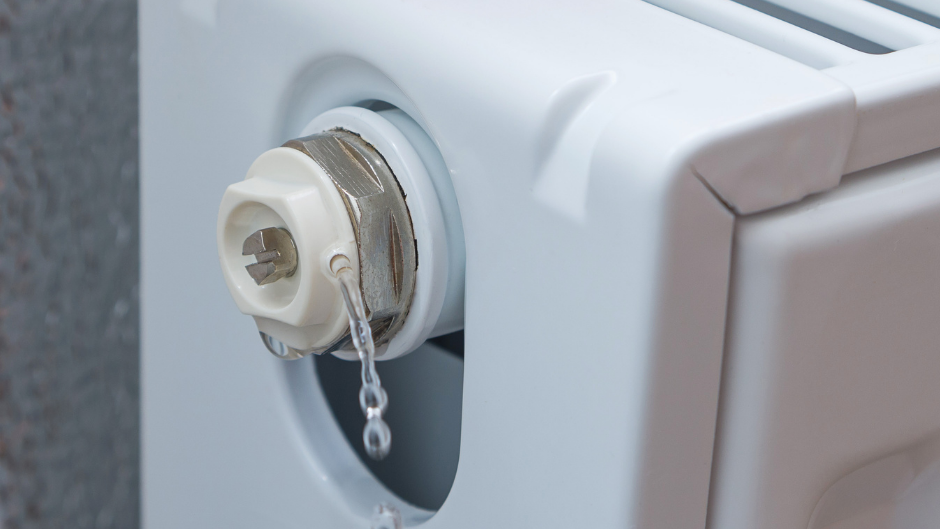
Which radiator do I bleed first?
If you’ve got several units that need venting then you’ll want to start downstairs with the radiator located closest to the boiler. You can then make your way around the rest of the radiators downstairs before heading upstairs to complete the process.
Step 5: Place a container or towel below the bleed valve
This is an optional step in order to catch any water spillage that might come spurting out of the radiator as you loosen the bleed valve. Simply place a container (such as a washing up bowl) underneath the valve and use a towel or cloth to catch any drops that come out of the valve.
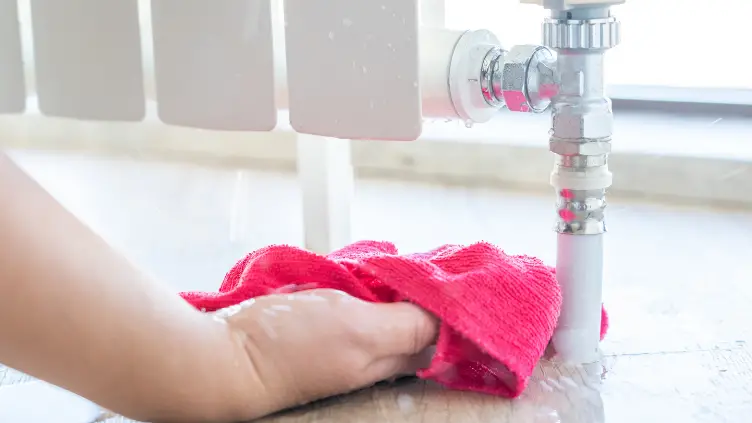
Step 6: Open the bleed valve with your bleed key (turn anti-clockwise)
Using your radiator key, simply turn the radiator valve anti-clockwise a 1/4 turn in order to start releasing the air.
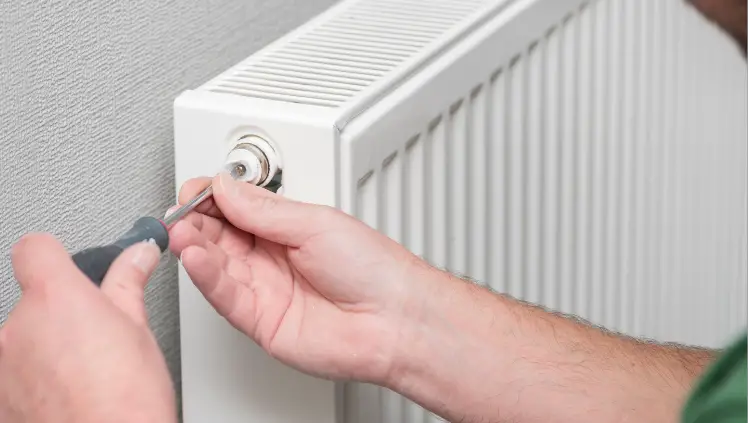
How to bleed a radiator without a radiator bleed key?
If you don’t have a radiator bleed key you can sometimes use a flathead screwdriver for this. Simply insert it into the hole where the bleed valve sits and gently push upwards until you hear the hiss of air being released (see image above).
Step 7: Listen for a hissing sound of air escaping
If you’ve done the previous step correctly, you should notice a hissing sound as the air escapes from the radiator bleed valve. Keep going until the hissing stops or water leaks out of the valve. Be prepared as this can stop very abruptly and you’ll have water leaking out of the valve.
How long do you let a radiator bleed for?
It should take between 30-60 seconds to release all of the air from your radiator. Although, this will depend on the extent of the venting problem. The more air in your system the longer it will take so just listen out for water to reach the bleed valve before you stop.
Step 8: Once the hissing stops, close the bleed valve (turn clockwise)
Now that the hissing has stopped and/or some water has come out of the radiator, you can quickly turn the radiator key clockwise in order to prevent any more water spilling onto your towel.
Step 9: Repeat the process for your other cold radiators
Repeat steps 4-8 for each of the cold radiators in your home and you will have successfully bled the entire central heating system.
Step 10: Check your boiler pressure
As a precaution, now that you’ve released hot water and air from the system there will likely be a reduction in the boiler pressure so you may want to increase to BAR pressure back to it’s original range. You can do this by adjusting the filling loop.
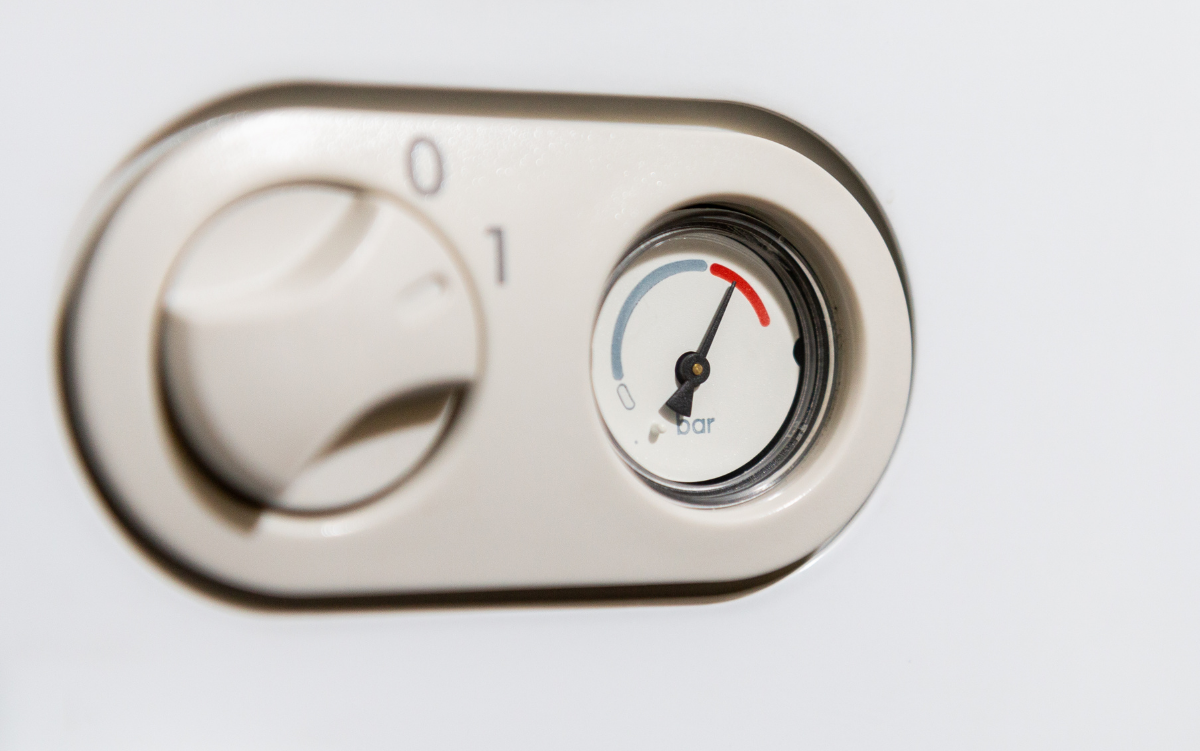
When Should You Bleed Your Radiators
You should bleed your radiators if you notice any of the following signs:
1. The Top of Your Radiators are Cold
If your radiators are cold at the top but warm on the bottom, this could indicate that there is air trapped in the top of the radiator which isn’t able to transfer heat effectively (air doesn’t transmit heat as well as water does). Check out our full guide on why is my radiator cold here.
2. The Entire Radiator is Cold
If the entire radiator is cold, this could be an indication that there is sludge in the system. Sludge can build up over time which prevents the circulation of water through the pipes. This means that no matter how much how water you add into the system, none of it makes its way down to the lower parts of the unit where it needs to go. In order to clear the blockages, you’ll need to drain all the water from the system and replace it with fresh water. If you suspect that you’ve got sludge in your system, why not check out our guide on how to flush a radiator system?
3. There’s Mould on the walls in Your Home
If you see mould developing in your home, particularly in spots that are in close proximity to your radiators, this could be a sign that they aren’t heating up effectively. This means that the heat isn’t sufficiently circulated through the room, allowing for moisture to evaporate. You should also consider if you’ve recently been drying your clothes on your radiators, as this can lead to mould formation too.
4. There’s A Rattling or gurgling noise within radiators
A rattling noise in your radiator might indicate that something is blocking one of the tubes inside the radiator itself. You can try turning off the power supply to the radiator and then gently tapping around the area where the rattle occurs. If the problem persists, you’ll probably need to get someone who knows what they’re doing to fix it. Blocking a pipe can cause serious damage to the system if left untreated so we would always recommend getting this checked out.
Why should you bleed your radiators?
Bleeding your radiators is essential if you’re looking to keep your central heating system efficient and economical for your heating bills. When you have trapped air in your radiators, your boiler will burn more energy trying to heat up the radiators to full temperature.
The trapped air acts as an insulator that is ineffective at transferring the heat energy of the boiler through the steel radiator and into the room. So if you’re looking to keep your energy bills low
How often should you bleed your radiators?
You should routinely bleed your radiators between 2-3 times per year. However, we advise that you should bleed your radiators whenever you notice the warning signs of trapped air such as cold spots, rattling sounds or finding mould in your home.

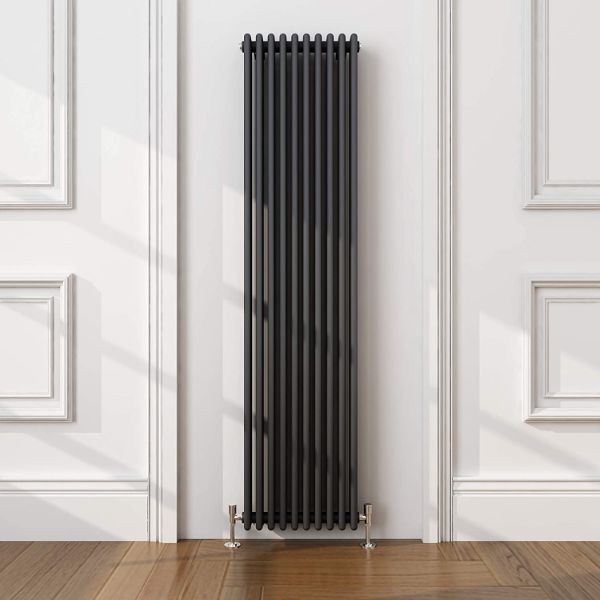


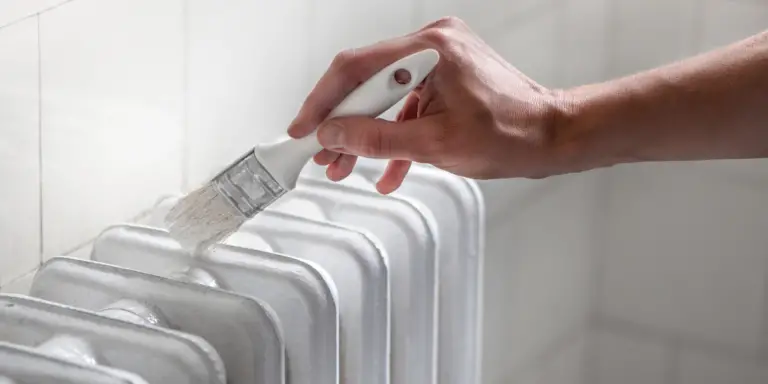

Duel fuel towel rail radiator bleed point.
For many years I have ‘bled’ our central heating radiators quite expertly (minus a bathroom towel rail) I now have
2 duel fuel bathroom vertical towel rails one of which does not heat up when the central heating is turned on. whereby I have managed locate the ‘bleed’ valve component and unscrewed the ‘flat’ end – then removed the cylindrical sheath – turned it, so that the cylindrical sheath end with the small square ‘hole’ fits neatly over the protruding male ‘rod’ (in which presumably to turn accordingly). However at the end of the ‘rod’ closest to the valve itself there is a semicircle clip At this point I am ‘above my pay grade’. Do I remove the clip and if so how do I actually bleed the radiator and at what point to I struggle to replace the clip. (by looking at the rod I can’t see if the is a semicircle ‘groove’ (on the rod) into which to neatly position the clip.
Hi Howard,
Thank you for reaching out to us about your bathroom vertical towel rails and apologies in the delayed response. We appreciate your detailed description, and we’re here to help you find a solution to the issue.
I’m afraid we’re not entirely sure what you mean by the semi-circle clip so we would suggest seeking the assistance of a qualified plumber or heating engineer who can evaluate the situation and provide specific advice on how to proceed. They can also help you identify any issues that may be causing the radiator to not heat up properly and provide specific guidance on how to bleed the radiator safely and effectively.
I hope this helps, if you have any more questions please feel free to get back to us.
Warm wishes,
James